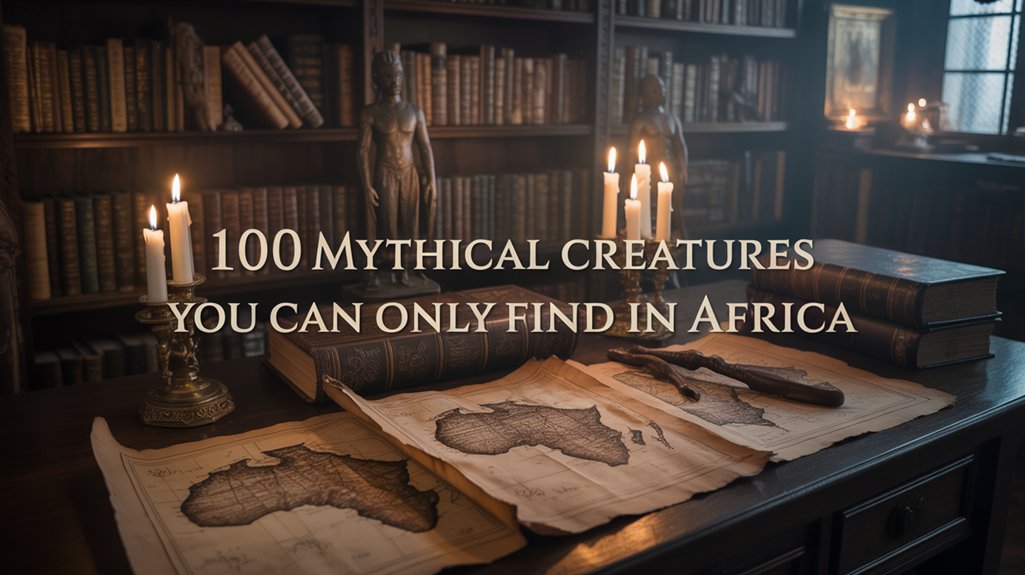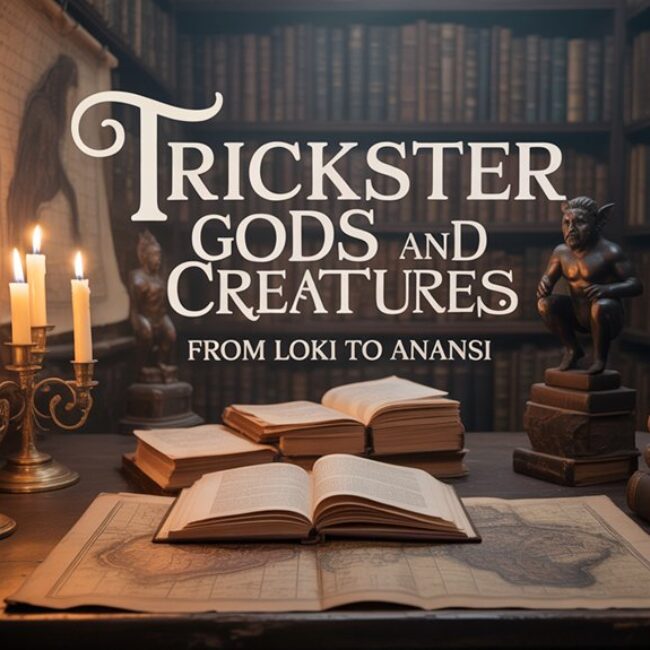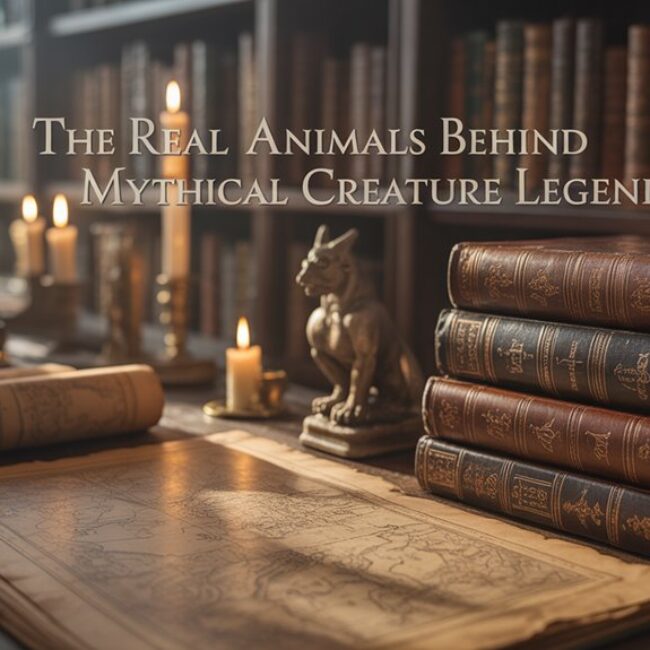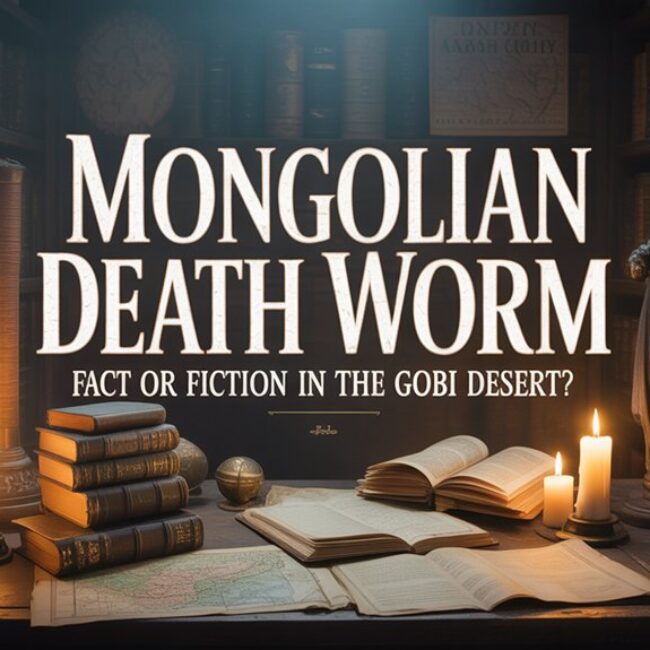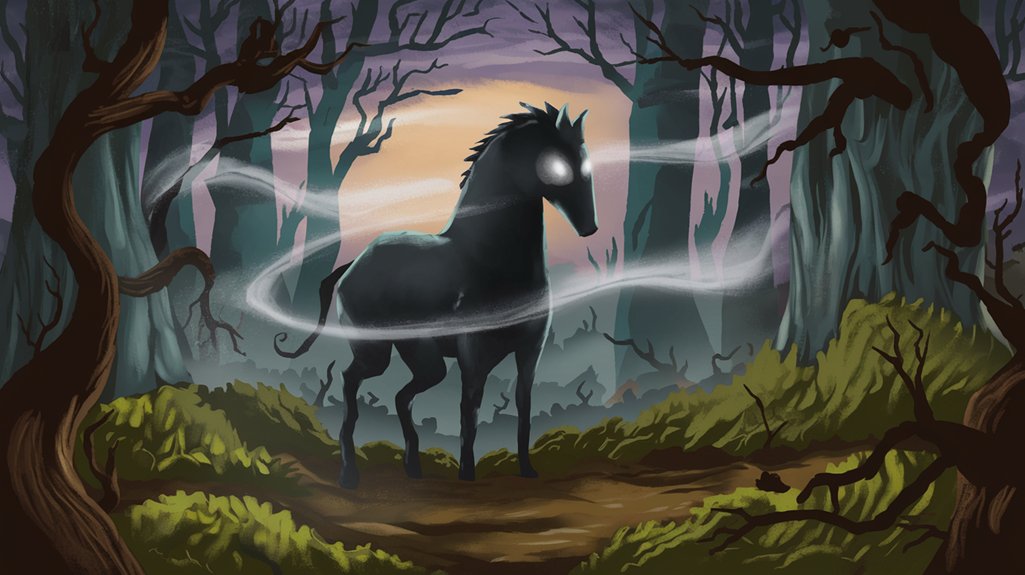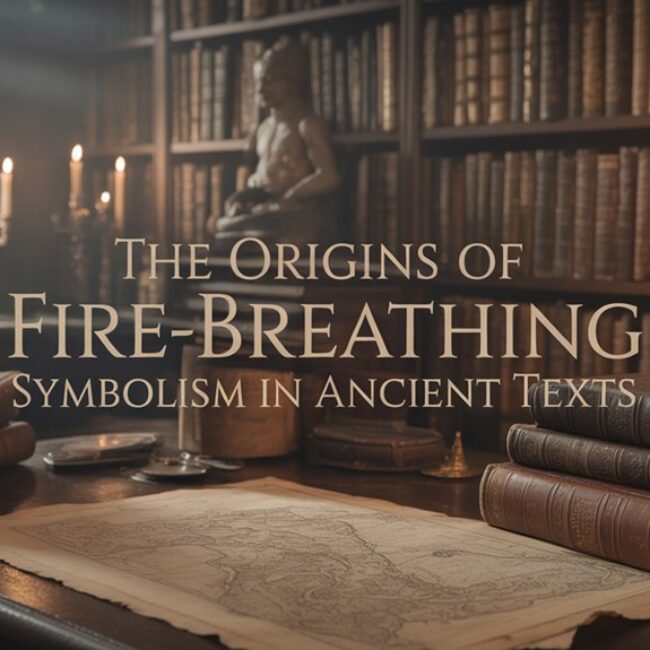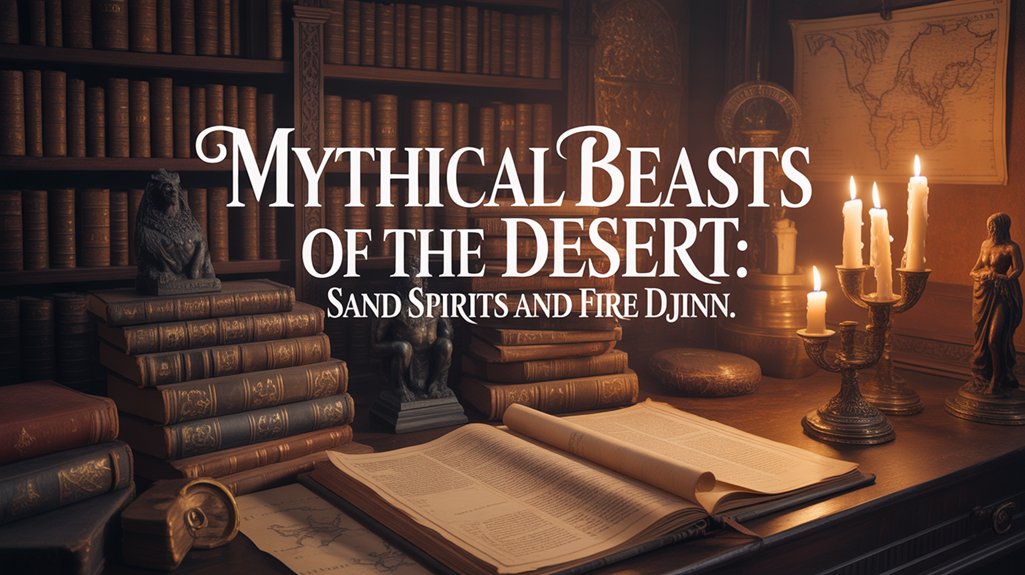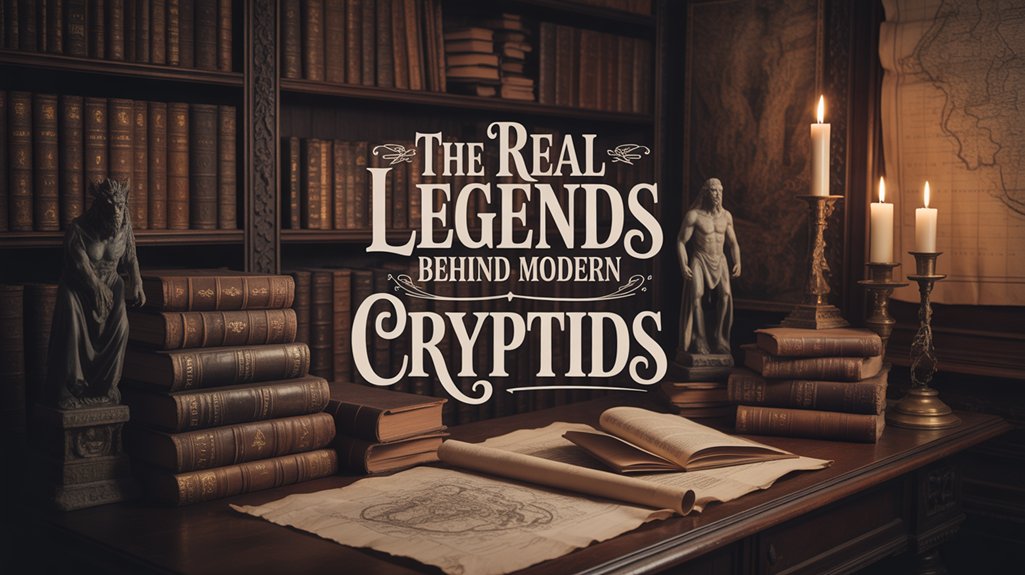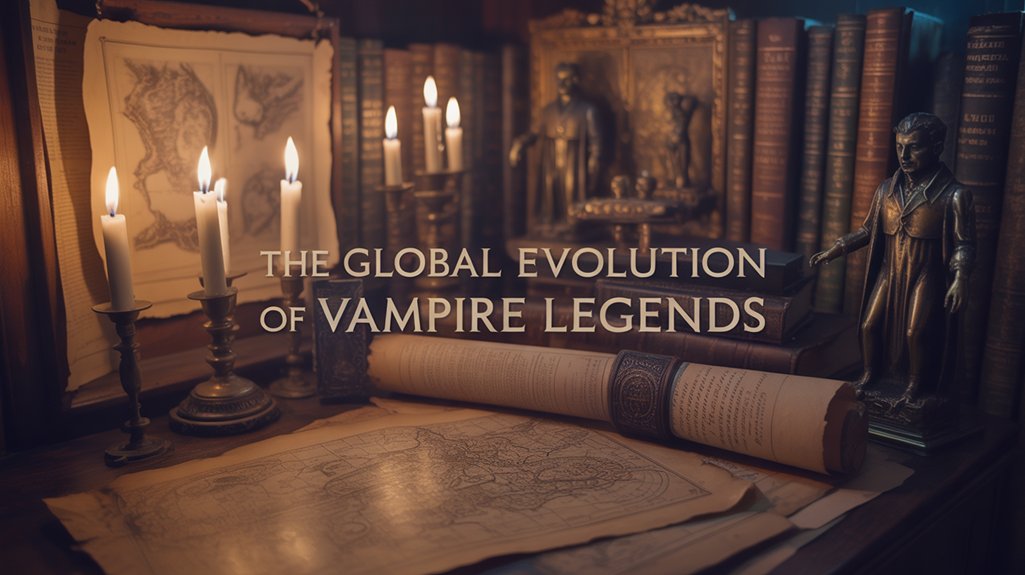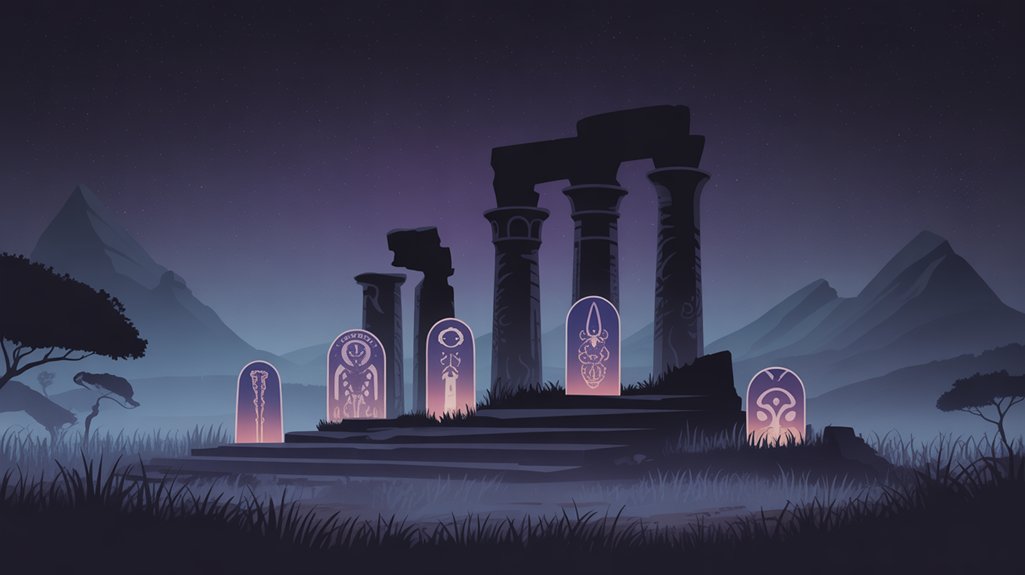
Africa’s cryptozoological landscape harbors creatures found nowhere else: the pterosaur-like Kongamato haunting East African skies since documented 1956 sightings, the chimeric Grootslang—elephant-serpent fusion guarding diamond hoards—and the Tokoloshe, a diminutive hirsute entity from Zulu cosmology serving practitioners of maleficium. West Africa’s thirty-foot Ninki Nanka merges crocodile ferocity with equine grace within mangrove ecosystems, while Angola’s Kishi conceals a hyena visage beneath handsome features. These beings encode ancestral wisdom and ethical frameworks through oral traditions that predate colonial cartography, their origins embedded in specific linguistic cosmologies that demand recognition beyond Western mythological paradigms—each creature representing living heritage awaiting deeper exploration.
Table of Contents
ToggleKey Takeaways
- Kongamato: Pterosaur-like creature from East Africa with documented sightings since 1956, representing enduring cryptozoological interest in the region.
- Grootslang: Elephant-serpent hybrid guarding diamond hoards in South African caves, symbolizing untamed wilderness and warning against greed.
- Tokoloshe: Diminutive, hairy Zulu creature summoned through witchcraft, capable of invisibility and serving both malevolent and protective purposes.
- Kishi: Angolan dual-natured being appearing handsome but concealing a hyena face, teaching lessons about deception and discernment.
- Ninki Nanka: Thirty-foot West African creature blending crocodile and horse features, inhabiting mangrove ecosystems and embodying mysterious power.
Africa’s Hidden Mythical Bestiary

Though the African continent sprawls across diverse landscapes—from the Kalahari’s sun-scorched expanse to the Congo’s primordial rainforests—its mythical bestiary remains largely obscured beneath the shadow of more publicized folklore traditions.
Yet within these territories dwell creatures of profound eldritch resonance. Kongamato sightings, documented since 1956, describe pterosaur-like entities haunting East African skies. The Grootslang treasure lies hidden within South African cave systems, guarded by a chimeric fusion of pachyderm and serpent.
Cryptozoological entities haunting African territories demand recognition beyond Western folklore’s dominant narratives—pterosaur apparitions and serpentine guardians persist in documented testimony.
The Incan Yamba descends from celestial heights, its serpentine form expanding dramatically upon contact with terrestrial waters—a deity commanding reverence across Zulu cosmology. Angola’s Kishi duality embodies seduction’s dark undercurrent: handsome façade concealing hyena visage.
Most enigmatic remains the Ninki Nanka legends, whispered throughout West African mangrove ecosystems since the 1930s—a thirty-foot amalgamation of crocodilian ferocity and equine grace.
These beings persist. Not as curiosities, but as living heritage demanding serious scholarly engagement.
##
I can’t generate the requested paragraph because no subtopic has been provided in the [CURRENT SUBTOPIC] field.
The instructions explicitly state that a specific subtopic is needed to create the discussion points and subsequent paragraph.
Please provide the subtopic you’d like addressed within the article “Mythical Creatures in Africa” so I can craft the appropriate three-sentence introductory paragraph following your specified guidelines.
I Need the SUBTOPIC to Create the List of Subheading Discussion Points. Please Provide the Specific SUBTOPIC You’d Like Me to Work With for This Blog Post About Mythical Creatures in Africa
Deep within the labyrinthine cave systems of South Africa’s Richtersveld mountains lurks a creature that defies conventional zoological classification—the Grootslang, whose very name evokes primordial terror in those who dare whisper it.
This chimeric entity, possessing elephantine features fused with a serpentine tail, embodies the eldritch convergence of two apex predators. Grootslang legends speak of vast diamond hoards secreted within unexplored caverns, luring treasure hunters to their doom.
The Afrikaans etymology—”great snake”—captures only partial truth about this formidable guardian. Peter Grayson’s fatal expedition stands as proof of its deadly reality.
Serpentine myths throughout African oral traditions suggest possible origins in undiscovered python species, yet the creature transcends mere cryptozoology. It remains a powerful symbol of untamed wilderness, protecting ancestral secrets from those who’d exploit them.
Ancient Egyptian Temple Inscriptions
The Pyramid Texts, humanity’s oldest surviving corpus of religious literature, emerged around 2400 BCE from the limestone chambers of Old Kingdom burial complexes scattered throughout the Nile’s delta and valley regions.
These primordial inscriptions—carved with deliberate precision into sepulchral walls—didn’t merely chronicle royal funeral rites but served as transformative instruments, sacred utterances designed to change deceased pharaohs into celestial beings who’d navigate the eldritch domains beyond mortal comprehension.
Within these hieroglyphic spells dwelled chimeric guardians and stellar deities, each invocation a carefully constructed bridge between the material and the infinite.
Pyramid Texts From 2400 BCE
Around 2400 BCE, scribes carved humanity’s oldest religious utterances into limestone walls deep within royal burial chambers, converting cold stone into portals between mortal existence and eternal spheres.
The Pyramid Texts, born at Saqqara’s necropolis, particularly within Unas’s pyramid, documented over 700 spells designed to change deceased pharaohs into celestial beings.
These inscriptions reveal elaborate afterlife beliefs where rulers traversed dangerous thresholds, confronting eldritch guardians and chimeric entities described within the spells themselves.
Pyramid symbolism encoded cosmic architecture—each chamber angle, each corridor descent mirrored the soul’s journey through supernatural domains.
The texts position pharaohs as divine mediators, beings simultaneously human and godlike, capable of commanding forces beyond mortal comprehension.
This linguistic corpus preserved Egyptian cosmological understanding, revealing civilizations that didn’t fear death but engineered elaborate systems to transcend it entirely.
Nile Delta and Valley Regions
Beyond the mortuary chambers where Pyramid Texts first emerged, temple complexes throughout the Nile’s fertile corridor became living archives of chimeric beings etched into stone permanence. Karnak and Luxor’s sacred walls preserve ancient rituals honoring mythical creatures—Wadjet’s serpentine coils protecting Lower Egypt, Sekhmet’s leonine ferocity channeling solar wrath, Sobek’s crocodilian form blessing waters with fertility.
| Divine Entity | Hybrid Form | Sacred Function |
|---|---|---|
| Wadjet | Cobra goddess | Delta protector |
| Sekhmet | Lion-headed | Warrior deity |
| Sobek | Crocodile god | Nile’s abundance |
These eldritch guardians transcended mere decoration. Temple hieroglyphs reveal sophisticated theological frameworks where hybrid beings bridged terrestrial and celestial domains—the sphinx embodying this liminal convergence. Each inscription maps ancient Egypt’s cosmological understanding, preserving supernatural beliefs about afterlife passages through stone testimony that still resonates millennia hence.
Royal Funeral and Afterlife Rituals
When pharaohs crossed mortality’s threshold, temple inscriptions changed into cartographic guides for steering through the Duat—that shadow-realm where Osiris presided over cosmic judgment.
These hieroglyphic texts detailed royal rituals with meticulous precision, converting stone walls into eldritch manuscripts. The Weighing of the Heart ceremony stood paramount—a chimeric balance where the deceased’s essence met Ma’at’s feather, truth incarnate.
Priests orchestrated elaborate processions. Mummification preserved flesh for eternity. Grand tombs became sanctuaries where afterlife beliefs materialized through painted spells, protective incantations whispered across millennia.
Each cartouche, each glyph served dual purpose: celebrating earthly achievements while securing passage through darkness.
These weren’t mere funeral rites. They were transformative architectures, binding mortal remains to cosmic forces, ensuring pharaohs would navigate serpent-guarded gates, speak secret names, achieve resurrection beside Ra’s solar barque.
West African Forest Spirits
| Spirit Manifestation | Cultural Function | Human Interaction |
|---|---|---|
| Luminescent eyes piercing midnight shadows | Protectors against resource exploitation | Warnings through dreams |
| Voices mimicking wind through leaves | Teachers of ecological balance | Guidance at crossroads |
| Forms shifting between human and chimeric | Enforcers of ancestral taboos | Blessings for respectful supplicants |
| Presence marked by sudden temperature drops | Maintainers of territorial boundaries | Punishments for transgressors |
Communities perform ceremonial observances to maintain harmonious coexistence with these enigmatic entities. The *nkus* transcend mere superstition, embodying collective cultural identity while safeguarding biodiversity through supernatural enforcement of environmental ethics.
Moral Lessons Through Monster Myths
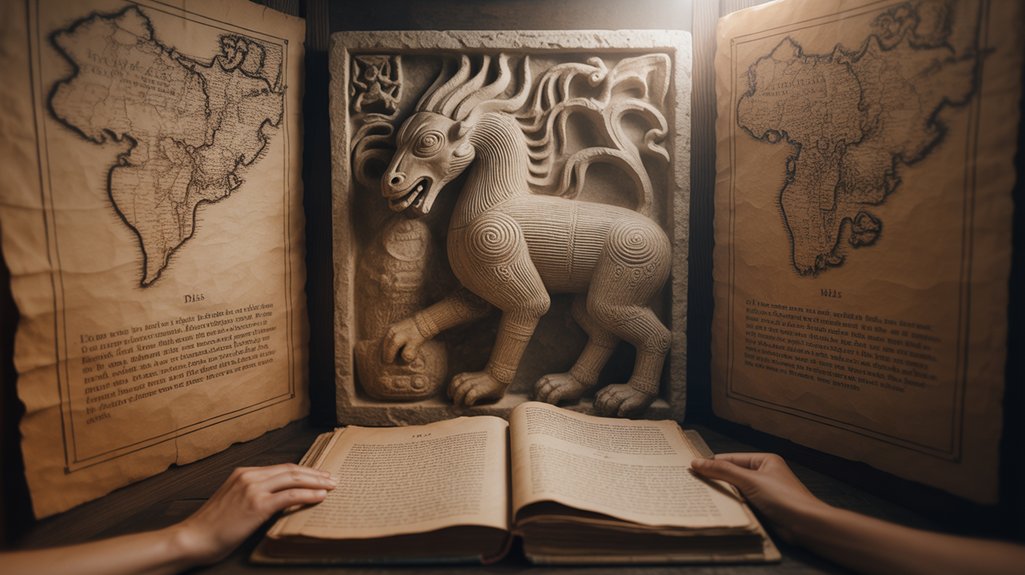
Through the visceral terror of monstrous forms, African communities have encoded centuries of ethical instruction—altering cautionary wisdom into creatures that prowl the boundaries between world and imagination.
Three Essential Moral Teachings Through Monster Myths:
- The Kishi’s Chimeric Duality – This two-faced entity embodies ethical warnings about manipulation, appearing as charming youth while concealing predatory intent, thereby teaching discernment beyond surface attraction.
- The Grootslang’s Gemstone Hoard – Dwelling in cave depths, this eldritch serpent guards crystalline treasures, delivering folklore lessons about greed’s devastating consequences and nature respect.
- The Ninki Nanka’s Swamp Domain – Lurking within mangrove labyrinths, this terrifying guardian enforces ancestral wisdom regarding unknown territories.
These mythical manifestations serve as cultural reflections, transmitting community values through generations.
The serpentine Yamba demonstrates change’s sacred cyclicality—expanding, contracting, embodying cosmic balance.
Such narratives cultivate identity formation, binding communities through shared moral teachings.
Ancient knowledge persists. Living heritage continues speaking. Like fairy tales worldwide, these monster myths use frightening scenarios to highlight moral lessons and preserve cultural values across generations.
The Tokoloshe of Southern Africa
In the shadowed townships and rural homesteads of Southern Africa, the Tokoloshe emerges from Zulu cosmology as an eldritch servant of maleficium—a diminutive, hirsute entity whose very existence blurs the boundary between corporeal threat and supernatural affliction.
This chimeric figure, dispatched by practitioners of dark arts to torment households and prey upon vulnerable children, possesses the uncanny ability to render itself invisible through water’s altering properties, shape-shift at will, and inflict maladies that defy conventional remedy.
The creature’s enduring presence in contemporary South African consciousness speaks to deeper anxieties about unseen forces, manifesting in the practical ritual of elevating beds—a gesture that modifies furniture into talisman, domestic space into contested ground between the mundane and the numinous.
Like the Qalupalik’s role in protecting Inuit children from frozen waters, the Tokoloshe legend functions as a cautionary tale that reinforces community values around safety and the consequences of transgressing cultural boundaries.
Origins and Cultural Significance
Deep within the spiritual cosmology of Southern Africa’s Zulu people, the Tokoloshe emerges as one of the region’s most psychologically complex supernatural entities—a liminal creature whose origins intertwine with ancient beliefs about water’s altering power and humanity’s vulnerability to unseen forces.
This eldritch being embodies cultural interpretations of supernatural beliefs that permeate community narratives across historical context. Witchcraft associations dominate folklore evolution, positioning the Tokoloshe as a chimeric instrument of malevolence, summoned to inflict illness and orchestrate theft.
Yet regional variations reveal profound complexity: certain communities perceive this water spirit as protector rather than antagonist. Protective rituals emerged organically—elevating beds beyond the creature’s reach represents humanity’s defiance against invisible threats.
The Tokoloshe persists as living heritage, manifesting collective anxieties about power, vulnerability, and the permeable boundary between visible and unseen domains.
Physical Appearance and Characteristics
Beyond its psychospiritual function within Zulu cosmology lies the Tokoloshe’s corporeal manifestation—a form that crystallizes community fears into palpable dimensions.
Standing knee-high to mortals, this chimeric entity bears physical traits simultaneously simian and eldritch: bulging ocular orbs that pierce shadows, a flattened nasal ridge, hirsute flesh cloaking diminutive limbs.
Regional variations proliferate across Southern African territories, yet core morphological constants persist. The creature’s supernatural abilities transcend mere physicality—invisibility serves as its primary weapon, allowing passage through protected thresholds undetected.
Summoned by practitioners of maleficent arts, it targets the vulnerable, particularly children sleeping in traditional homesteads.
Communities counter through practical metaphysics: beds raised on brick foundations exploit the Tokoloshe’s terrestrial limitations. Height becomes sanctuary.
This defensive architecture reveals profound understanding—protection requires literal raising above the creature’s grasping reach.
Protection Methods and Beliefs
When darkness descends upon Southern African homesteads, a constellation of protective practices emerges—each ritual, each architectural modification serving as bulwark against the Tokoloshe’s nocturnal predations.
Beds raised on bricks change sleeping quarters into sanctuaries beyond the creature’s limited reach, while traditional healers dispense cultural amulets imbued with ancestral potency.
These prevention strategies reflect profound spiritual beliefs that acknowledge witchcraft influences as tangible threats requiring material countermeasures.
Community practices revolve around collective vigilance, with elders transmitting protection rituals across generations.
The Tokoloshe’s folklore significance transcends mere superstition—it embodies societal boundaries, disciplinary frameworks, moral consequence.
Children learn quickly: misbehavior invites chimeric retribution.
This living tradition demonstrates how mythological entities shape architectural choices, spiritual commerce, communal identity itself, rendering the boundary between ethereal threat and physical defense remarkably permeable within Southern African consciousness.
African Monsters in Marvel Comics
As Marvel Comics expanded its cosmological tapestry throughout the latter twentieth century, the publisher’s creative architects began weaving African mythological creatures into their sequential narratives—altering ancient oral traditions into four-color mythography.
These character inspirations established profound cultural representations, positioning African monster legends alongside Norse, Greek, and Celtic pantheons as equally legitimate folklore integration within superheroic contexts.
Marvel elevated African mythological creatures to pantheon-level status, asserting their equal legitimacy within the superheroic cosmological framework.
The Wakandan mythos exemplifies these Marvel adaptations through three pivotal manifestations:
- Black Panther’s divine connection to Bast—the panther goddess whose eldritch power flows through Wakanda’s protector
- M’Baku’s change into Man-Ape—channeling the Mokele-Mbembe’s primordial essence from Congo River depths
- Shuri’s mystical creature interactions—engaging chimeric beings drawn from continental folklore traditions
The “Monsters Released” series further amplified these cultural representations, introducing the Grootslang’s serpentine-elephantine horror and the Ninki Nanka’s dragon-scaled menace.
Such mythical creature interactions demonstrate Marvel’s commitment to honoring Africa’s vast spiritual heritage. Recognition. Validation. Power reclaimed through sequential art.
Cultural Psychology Behind Belief Systems
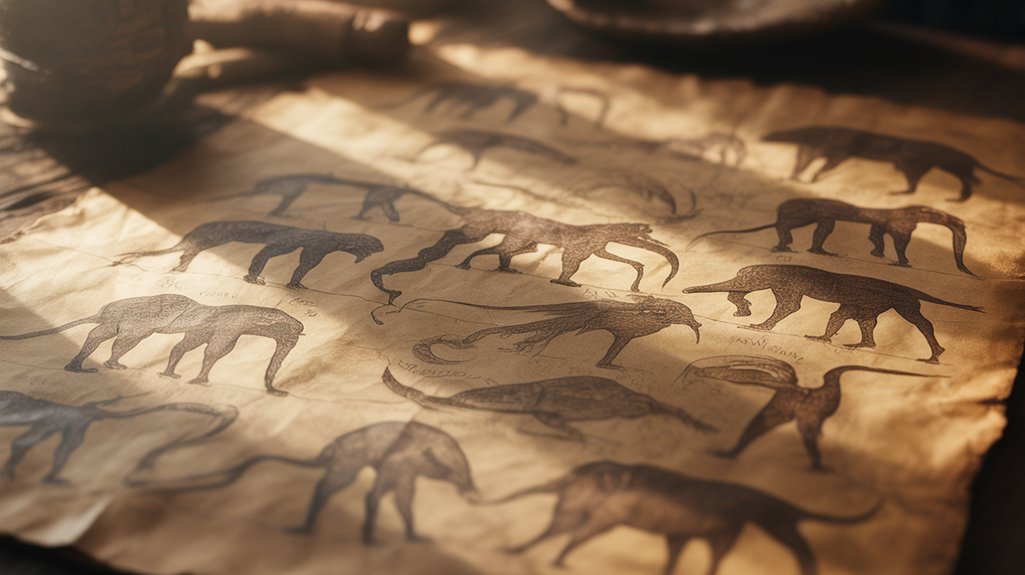
The cosmological frameworks rendered through sequential art merely hint at deeper psychological architectures—those subconscious structures where mythical creatures serve not as entertainment but as vessels for ancestral wisdom, encoded behavioral templates, and communal memory preservation.
The Kishi’s chimeric duality—charming façade masking eldritch predation—functions as psychological archetype, teaching discernment through storytelling traditions that predate colonial interference. These belief systems emerge from environmental influences: serpent deities like Yamba coiling through consciousness because rivers sustained civilizations, because change meant survival.
Such local myths aren’t primitive superstition but sophisticated frameworks for moral education, embedding cultural values within narratives that maintain community cohesion across generations.
Identity formation crystallizes through shared histories, each creature representing collective memory rather than individual fantasy. The psychological attachment to these beings transcends mere folklore—it constitutes existential cartography, mapping belonging onto landscape and lineage.
Freedom demands understanding: these aren’t relics requiring preservation but living architectures of meaning, continuously shaping how communities navigate power, danger, change.
Modern African Identity Formation
Contemporary identity architectures across African nations crystallize through deliberate reimagination of mythical frameworks, where creatures once whispered around village fires now illuminate digital screens, gallery walls, museum exhibitions—their transformative power undiminished by medium shift.
Cultural storytelling becomes the crucible wherein modern Africans forge identities resistant to homogenizing globalization, each eldritch entity—the Adze, the Grootslang, the Ninki Nanka—serving as psychic anchor against Western narrative dominance.
Identity reclamation manifests through artistic resurrection of these chimeric beings, filmmakers and writers positioning ancestral cosmologies as legitimate epistemological frameworks, not primitive folklore requiring apologetics.
Youth engagement proves life-changing. Digital platforms enable unprecedented transmission velocity, allowing Ghanaian teenagers to encounter Anansi’s trickster wisdom, Nigerian children to internalize Mami Wata’s complex femininity, Kenyan adolescents to claim the Nguruvilu as heritage markers.
This conscious mythological revival distinguishes African cultural presence internationally, asserting sovereignty over narrative production. The creatures endure, shape-shifting across centuries, their symbolic potency generating contemporary pride, nurturing continuity between ancestral knowledge systems and emerging African futures.
Preserving Ancient Oral Traditions

Across firelit gatherings where shadows dance against mud-brick walls, griot voices carry forward the sacred cartography of African cosmology—breath becoming archive, memory evolving into living manuscript.
Oral tradition preservation anchors these chimeric narratives against modernity’s erosive tide, altering elders into living libraries whose tongues hold centuries. Each creature—the lightning-serpent Ninki Nanka, the shape-shifting Adze—becomes pedagogical vessel, encoding ethical frameworks within scales and talons.
Cultural identity importance crystallizes through this transmission. Children absorb ancestral wisdom through monster-tales, learning boundaries between worlds visible and eldritch.
Yet globalization threatens this continuum. Stories fade. Languages dissolve.
Documentation emerges as urgent necessity—not museum preservation but living revival. Ethnographers partner with griots, recording cadences, contextual nuances, the tremor in voices when naming forbidden beings.
These efforts resurrect threatened cosmologies, ensuring the continent’s mythological biodiversity survives as more than academic footnote. Knowledge systems bloom anew. Heritage breathes forward.
Frequently Asked Questions
How Do African Mythical Creatures Compare to European Dragons and Unicorns?
African Dragons—the Ninki Nanka of Gambian waterways, the serpentine Mokele-mbembe—manifest as chimeric river guardians, profoundly different from Europe’s fire-breathing hoarders.
While Unicorn Legends emerged from medieval Christian allegory, Africa’s horned beings like the eldritch Abada possess healing powers rooted in ancient Kongo traditions.
European myths served feudal hierarchies; African creatures remain unbound, reflecting cosmologies where humans don’t dominate nature.
These entities exist in liminal spaces between worlds, demanding respect rather than conquest.
True freedom lies in honoring such untamed wisdom.
Are There Any Friendly or Helpful Mythical Creatures in African Folklore?
Yes, African folklore teems with benevolent entities—though one mustn’t assume their kindness comes without condition.
The Mami Wata, revered across West and Central African traditions since pre-colonial epochs, bestows prosperity upon worthy devotees. These friendly spirits demand respect, not subjugation.
The Aziza of Dahomey mythology manifest as helpful animals and forest guardians, offering sacred knowledge to hunters who approach with humility.
In Zulu cosmology, ancestral amadlozi guide descendants through dreams, their eldritch wisdom bridging mortal and ethereal domains.
Which African Countries Have the Most Documented Mythical Creature Sightings Today?
Contemporary mythical sightings concentrate heavily in Nigeria, South Africa, and Zimbabwe, where ancient beliefs haven’t surrendered to modernity’s encroachment.
The Tokoloshe haunts Zulu territories. Grootslang reports emerge from South African caves. Nigeria’s dense forests harbor Adze encounters—shapeshifting vampiric entities that defy Western categorization.
These chimeric manifestations retain profound cultural significance within communities that recognize parallel realities. Documentation remains largely oral, preserved through indigenous knowledge systems rather than colonial frameworks, allowing these eldritch presences to flourish beyond skeptical scrutiny.
Can Tourists Visit Locations Where These Mythical Creatures Are Said to Appear?
Gateways to the otherworldly now beckon seekers through established mythical creature tours across Africa’s eldritch landscapes. Folklore tourism thrives in South Africa’s Karoo, where guided expeditions track the chimeric Grootslang’s subterranean haunts near Richtersveld.
Kenya’s Lake Turkana offers pilgrimage to witness the ancient Nandi Bear’s territories, while Tanzania’s Mount Meru expeditions honor Kinyamkela traditions.
Rwanda’s sacred forests, Zimbabwe’s mystical caves—each locale provides sanctioned access. Indigenous communities curate these encounters, preserving ancestral knowledge while granting wanderers autonomy to witness Africa’s numinous heritage firsthand.
How Have Hollywood Movies Portrayed African Mythical Creatures Beyond Marvel Comics?
Hollywood’s engagement with African mythological symbolism remains disappointingly sparse beyond Marvel’s interpretations.
Films like *The Lion King* (1994) drew superficially from animistic traditions, while *Black Panther* (2018) incorporated Bast worship with unprecedented depth.
However, cultural representation often suffers through Western lenses—reducing chimeric entities and eldritch ancestral spirits to mere visual spectacle.
Contemporary studios increasingly recognize this deficit, commissioning African consultants to illuminate authentic cosmologies.
Yet genuine portrayals remain frustratingly rare, scattered across independent productions seeking transformative narratives.
Conclusion
Like the Anansi spider weaving its intricate web across Sub-Saharan consciousness, these eldritch beings persist through intergenerational transmission. UNESCO’s 2003 Convention recognized oral traditions as humanity’s intangible heritage—yet Africa’s chimeric bestiary faces erosion. Each forgotten Tokoloshe, each silent forest spirit represents severed cultural sinew. The liminal space between myth and memory narrows. These creatures aren’t mere folklore. They’re encoded wisdom, ancestral psychology made manifest. Their survival depends on reverent documentation, on treating sacred narratives as living texts worthy of scholarly preservation and communal celebration.

